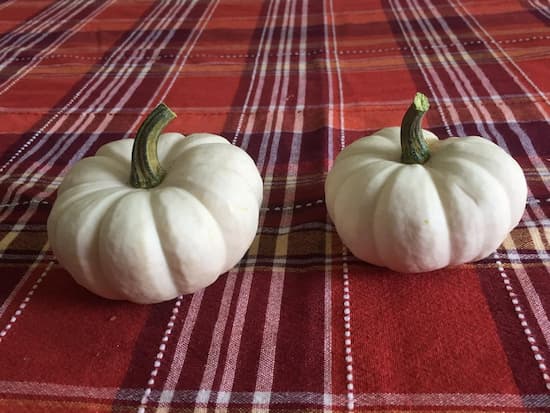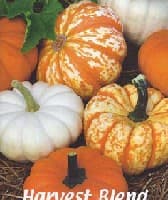How to Grow Miniature Pumpkins

How to Grow Miniature Pumpkins in Your Garden
Big pumpkins, small pumpkins, dontcha just love all pumpkins!? There’s a lot said and written about Jack O’Lanterns and giant pumpkins. But, just a wee little bit is written about those cute, little miniature pumpkins. So, let’s talk about how to grow miniature pumpkins. While they are a vining crop like their big brother the Jack O’Lantern, they take up less space in the garden. As a matter of fact, you can grow miniature pumpkins in almost no space at all. Try growing miniature Jack Be Little pumpkins and Baby Boo pumpkins up a fence or trellis. In addition to taking up less space, the fruit will be cleaner when kept off the ground. Sound like fun? It is! So, grab a packet of miniature pumpkin seeds and let’s get growing.
Speaking of space-constrained, if you don’t have a garden, try growing them in a five-gallon bucket on your balcony or deck. Either train them to go around the railing of your deck or just let the vines hang down from it.
Varieties of Miniature Pumpkins
Orange-colored varieties include Jack Be Little pumpkin, also called “JBL”, and Wee B. Little.
White-colored: We only know of one variety, called “Baby Boo pumpkins”.
You can often find miniature pumpkin seeds in a gourd mixture (See Harvest Blend pictured above). That’s because these cute little “pumpkins” that fit in the palm of your hand are actually gourds. (But, we won’t tell anyone that, if you don’t!)

How to Grow Miniature Pumpkins - Planting Seeds
Miniature Pumpkin seeds can be started indoors 2-3 weeks before the last frost date in your area. Plant two to three seeds in each pot. Then, thin to one seedling shortly after the seeds sprout.
Importantly, as soon as they sprout give them as much sun as possible.
Garden Tip: To minimize transplant shock, plant miniature pumpkin seeds into peat pots or peat pellets.
For outdoor starts, sow seeds directly into your garden. Plant these tender annuals outdoors after the last frost date for your area.
Days to Germination: 7 – 10 days. Longer in cool soil.
How to Grow Miniature Pumpkins - Season Long Care
Grow pumpkins in full sun. Pumpkins, even miniature varieties, are big feeders. Plant miniature pumpkin seeds in rich, well-draining soil. Mix in ample amounts of compost and manure before planting.
The plants require a lot of water. Keep the soil evenly moist, not wet. And, water more deeply as the season progresses and the roots grow deeper into the soil.
Ideal soil pH: 5.5 – 7.5 More on soil pH
Miniature pumpkins are vining plants. If you are limited in your garden space, plant them where they can grow on a trellis or fence. If you are growing them in a container select a very large one. Also, the container will hold limited amounts of water and nutrients. So, keep an eye on the moisture level of the soil. And, add fertilizer more frequently. Liquid fertilizer is great for any potted plant, including miniature pumpkins.
Grow miniature pumpkins like you would grow regular Jack O’Lantern pumpkins. Keep the soil moist. Avoid watering the leaves, if possible. Mulch heavily around the plants to help keep the weeds down, and to retain moisture.
It’s all in the Stem! The stem gives pumpkins character. This is even more true with your miniature pumpkins. When harvesting, be careful not to break the stem. Use a sharp knife to cut the stem. And, never hold or carry a pumpkin by the stem, as it can break.

Insects and Pests
Gardeners love pumpkins. Insects and a wide variety of pests love ’em, too. The most common insects are Cucumber beetles, squash vine borers, and squash bugs. Dusting or spraying regularly before an infestation occurs, is recommended.
Among the animals that love pumpkins (both the plants and the fruit) are bunnies, woodchucks, squirrels, and deer. Use animal repellent like pepper and garlic sprays as needed. More on sprays.
Plant Disease
A variety of diseases affect pumpkin plants, most notable is powdery mildew. Apply fungicides at the first sign of a problem. Better still, apply them before plant disease problems occur. Hot, humid weather encourages pumpkin diseases.
Tip: Allow enough time after watering for the leaves to dry before evening. Water on the leaves in warm weather encourages plant disease.
How to Grow Miniature Pumpkins - Harvest Time
Days to Maturity: Plan 90-100 days for these little pumpkins to grow and ripen. We always recommend new growers add a few days to this estimate.
The plants will produce up to 8-10 cute, little pumpkin fruits.
Harvest when they turn completely orange, and the stem has dried and turned brown. Cut the stem near the vine with a sharp knife. Also, be careful not to break the stem.
Use miniature pumpkins in decorating projects and displays. They look great in any and every room of your house.
Yes, miniature pumpkins are edible. Use them in a variety of recipes. They are great stuffed, or as bowls to serve puddings or Jell-O.
Plant Hardiness
Pumpkin plants are tender annuals. Protect them from frost and cold weather both spring and fall.
Miniature Pumpkin Recipes
May we suggest:
Pumpkin Puree – make your own puree. There’s none better!
Related Articles
People who read this article, also like:
How to Grow Big Pumpkins -and small ones, too.
Please support our site. Shop for:
- rmmatthews100@hotmail.com
- 585-721-6528
- Rochester, NY
©1999-2024 GardenersNet.Com, All Rights Reserved

